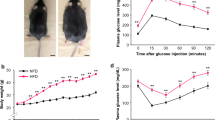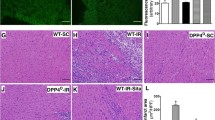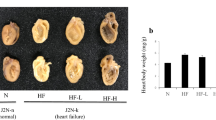Abstract
Dipeptidyl peptidase-4 (DPP4) enzyme inhibition has been reported to increase plasma glucagon-like peptide-1 (GLP-1) level for controlling postprandial glucose concentration. Both DPP4 inhibitors and GLP-1 analog have been approved for antihyperglycemic agents. In addition to the insulinotropic effect, GLP-1 signaling was reported to modulate cardiac function. DPP4 inhibition was shown to improve survival rate after myocardial infarction in mice, but the precise mechanism remains unknown. We aimed to compare the cardiovascular responses of ischemia/reperfusion (I/R) between wild-type and DPP4-deficient rats and investigate the underlying mechanism. Rats were subjected to 45 min of coronary artery occlusion, followed by reperfusion for 2 h. Cardiac function was characterized by analyzing pressure–volume loops. As compared to wild-type rats, after I/R, DPP4-deficient rats had better cardiac performance in association with less infarct size and cardiac injury markers (LDH, ANP, and BNP), which could be attenuated by exendin-(9–39), a GLP-1 receptor antagonist. Exendin-(9–39) could diminish the increased phosphorylation levels of myocardial AKT and GSK-3β as well as the higher expression of GLUT4 in post-infarcted DPP4-deficient rats. However, exendin-(9–39) could not completely abrogate the less infarct size in DPP4-deficient rats as compared with that in wild-type rats, implicating the involvement of GLP-1 receptor-independent pathway. In summary, this study demonstrated that the benefit of cardiac protective action against I/R injury was demonstrated in DPP4-deficient rats, which is mediated through both GLP-1 receptor-dependent and receptor-independent mechanisms.






Similar content being viewed by others
Abbreviations
- DPP4:
-
Dipeptidyl peptidase-4
- GLP-1:
-
Glucagon-like peptide-1
- ex(9–39):
-
Exendin-(9–39)
- I/R:
-
Ischemia/reperfusion
- LDH:
-
Lactate dehydrogenase
- PKA:
-
Protein kinase A
- PV loop:
-
Pressure–volume loop
- GSK:
-
Glycogen synthase kinase
- SDF-1:
-
Stromal cell-derived factor-1
References
Arakawa M, Mita T, Azuma K, Ebato C, Goto H, Nomiyama T, Fujitani Y, Hirose T, Kawamori R, Watada H (2010) Inhibition of monocyte adhesion to endothelial cells and attenuation of atherosclerotic lesion by a glucagon-like peptide-1 receptor agonist, exendin-4. Diabetes 59:1030–1037
Ban K, Noyan-Ashraf MH, Hoefer J, Bolz SS, Drucker DJ, Husain M (2008) Cardioprotective and vasodilatory actions of glucagon-like peptide 1 receptor are mediated through both glucagon-like peptide 1 receptor-dependent and -independent pathways. Circulation 117:2340–2350
Ban K, Kim KH, Cho CK, Sauve M, Diamandis EP, Backx PH, Drucker DJ, Husain M (2010) Glucagon-like peptide (GLP)-1(9–36)amide-mediated cytoprotection is blocked by exendin(9–39) yet does not require the known GLP-1 receptor. Endocrinology 151:1520–1531
Barragan JM, Rodriguez RE, Blazquez E (1994) Changes in arterial blood pressure and heart rate induced by glucagon-like peptide-1-(7–36) amide in rats. Am J Physiol 266:E459–466
Bhashyam S, Fields AV, Patterson B, Testani JM, Chen L, Shen YT, Shannon RP (2010) Glucagon-like peptide-1 increases myocardial glucose uptake via p38alpha MAP kinase-mediated, nitric oxide-dependent mechanisms in conscious dogs with dilated cardiomyopathy. Circ Heart Fail 3:512–521
Boonacker E, Van Noorden CJ (2003) The multifunctional or moonlighting protein CD26/DPPIV. Eur J Cell Biol 82:53–73
Bose AK, Mocanu MM, Carr RD, Brand CL, Yellon DM (2005) Glucagon-like peptide 1 can directly protect the heart against ischemia/reperfusion injury. Diabetes 54:146–151
Burley DS, Hamid SA, Baxter GF (2007) Cardioprotective actions of peptide hormones in myocardial ischemia. Heart Fail Rev 12:279–291
Chen WP, Tzeng HJ, Ku HC, Ho YJ, Lee SS, Su MJ (2010) Thaliporphine ameliorates cardiac depression in endotoxemic rats through attenuating TLR4 signaling in the downstream of TAK-1 phosphorylation and NF-kappaB signaling. Naunyn Schmiedebergs Arch Pharmacol 382:441–453
Dokken BB, Hilwig WR, Teachey MK, Panchal RA, Hubner K, Allen D, Rogers DC, Kern KB (2010) Glucagon-like peptide-1 (GLP-1) attenuates post-resuscitation myocardial microcirculatory dysfunction. Resuscitation 81:755–760
Doupis J, Veves A (2008) DPP4 inhibitors: a new approach in diabetes treatment. Adv Ther 25:627–643
Drucker DJ (2006) The biology of incretin hormones. Cell Metab 3:153–165
Fehmann HC, Goke R, Goke B (1995) Cell and molecular biology of the incretin hormones glucagon-like peptide-I and glucose-dependent insulin releasing polypeptide. Endocr Rev 16:390–410
Fields AV, Patterson B, Karnik AA, Shannon RP (2009) Glucagon-like peptide-1 and myocardial protection: more than glycemic control. Clin Cardiol 32:236–243
Fujio Y, Nguyen T, Wencker D, Kitsis RN, Walsh K (2000) Akt promotes survival of cardiomyocytes in vitro and protects against ischemia-reperfusion injury in mouse heart. Circulation 101:660–667
Grieve DJ, Cassidy RS, Green BD (2009) Emerging cardiovascular actions of the incretin hormone glucagon-like peptide-1: potential therapeutic benefits beyond glycaemic control? Br J Pharmacol 157:1340–1351
Gros R, You X, Baggio LL, Kabir MG, Sadi AM, Mungrue IN, Parker TG, Huang Q, Drucker DJ, Husain M (2003) Cardiac function in mice lacking the glucagon-like peptide-1 receptor. Endocrinology 144:2242–2252
Hahm E, Lee YS, Jun HS (2008) Suppressive effects of glucagon-like peptide-1 on interferon-gamma-induced nitric oxide production in insulin-producing cells is mediated by inhibition of tumor necrosis factor-alpha production. J Endocrinol Invest 31:334–340
Hearse DJ, Bolli R (1992) Reperfusion induced injury: manifestations, mechanisms, and clinical relevance. Cardiovasc Res 26:101–108
Hua F, Ha T, Ma J, Li Y, Kelley J, Gao X, Browder IW, Kao RL, Williams DL, Li C (2007) Protection against myocardial ischemia/reperfusion injury in TLR4-deficient mice is mediated through a phosphoinositide 3-kinase-dependent mechanism. J Immunol 178:7317–7324
Juhaszova M, Zorov DB, Yaniv Y, Nuss HB, Wang S, Sollott SJ (2009) Role of glycogen synthase kinase-3beta in cardioprotection. Circ Res 104:1240–1252
Kleinbongard P, Schulz R, Heusch G (2011) TNFalpha in myocardial ischemia/reperfusion, remodeling and heart failure. Heart Fail Rev 16:49–69
Ku HC, Chen WP, Su MJ (2010) GLP-1 signaling preserves cardiac function in endotoxemic Fischer 344 and DPP4-deficient rats. Naunyn Schmiedebergs Arch Pharmacol 382:463–474
Michel MC, Fliers E, Van Noorden CJ (2008) Dipeptidyl peptidase IV inhibitors in diabetes: more than inhibition of glucagon-like peptide-1 metabolism? Naunyn Schmiedebergs Arch Pharmacol 377:205–207
Morimoto C, Schlossman SF (1998) The structure and function of CD26 in the T-cell immune response. Immunol Rev 161:55–70
Mullonkal CJ, Toledo-Pereyra LH (2007) Akt in ischemia and reperfusion. J Invest Surg 20:195–203
Nikolaidis LA, Elahi D, Hentosz T, Doverspike A, Huerbin R, Zourelias L, Stolarski C, Shen YT, Shannon RP (2004a) Recombinant glucagon-like peptide-1 increases myocardial glucose uptake and improves left ventricular performance in conscious dogs with pacing-induced dilated cardiomyopathy. Circulation 110:955–961
Nikolaidis LA, Mankad S, Sokos GG, Miske G, Shah A, Elahi D, Shannon RP (2004b) Effects of glucagon-like peptide-1 in patients with acute myocardial infarction and left ventricular dysfunction after successful reperfusion. Circulation 109:962–965
Nishihara M, Miura T, Miki T, Tanno M, Yano T, Naitoh K, Ohori K, Hotta H, Terashima Y, Shimamoto K (2007) Modulation of the mitochondrial permeability transition pore complex in GSK-3beta-mediated myocardial protection. J Mol Cell Cardiol 43:564–570
Noyan-Ashraf MH, Momen MA, Ban K, Sadi AM, Zhou YQ, Riazi AM, Baggio LL, Henkelman RM, Husain M, Drucker DJ (2009) GLP-1R agonist liraglutide activates cytoprotective pathways and improves outcomes after experimental myocardial infarction in mice. Diabetes 58:975–983
Ohnuma K, Dang NH, Morimoto C (2008) Revisiting an old acquaintance: CD26 and its molecular mechanisms in T cell function. Trends Immunol 29:295–301
Orskov C, Rabenhoj L, Wettergren A, Kofod H, Holst JJ (1994) Tissue and plasma concentrations of amidated and glycine-extended glucagon-like peptide I in humans. Diabetes 43:535–539
Ravingerova T, Matejikova J, Neckar J, Andelova E, Kolar F (2007) Differential role of PI3K/Akt pathway in the infarct size limitation and antiarrhythmic protection in the rat heart. Mol Cell Biochem 297:111–120
Reinhold D, Biton A, Goihl A, Pieper S, Lendeckel U, Faust J, Neubert K, Bank U, Tager M, Ansorge S, Brocke S (2007) Dual inhibition of dipeptidyl peptidase IV and aminopeptidase N suppresses inflammatory immune responses. Ann N Y Acad Sci 1110:402–409
Sauve M, Ban K, Momen MA, Zhou YQ, Henkelman RM, Husain M, Drucker DJ (2010) Genetic deletion or pharmacological inhibition of dipeptidyl peptidase-4 improves cardiovascular outcomes after myocardial infarction in mice. Diabetes 59:1063–1073
Sokos GG, Nikolaidis LA, Mankad S, Elahi D, Shannon RP (2006) Glucagon-like peptide-1 infusion improves left ventricular ejection fraction and functional status in patients with chronic heart failure. J Card Fail 12:694–699
Sonne DP, Engstrom T, Treiman M (2008) Protective effects of GLP-1 analogues exendin-4 and GLP-1(9–36) amide against ischemia-reperfusion injury in rat heart. Regul Pept 146:243–249
Thompson MA, Ohnuma K, Abe M, Morimoto C, Dang NH (2007) CD26/dipeptidyl peptidase IV as a novel therapeutic target for cancer and immune disorders. Mini Rev Med Chem 7:253–273
Tseng CC, Zhang XY, Wolfe MM (1999) Effect of GIP and GLP-1 antagonists on insulin release in the rat. Am J Physiol 276:E1049–1054
Ussher JR, Lopaschuk GD (2008) The malonyl CoA axis as a potential target for treating ischaemic heart disease. Cardiovasc Res 79:259–268
Vila Petroff MG, Egan JM, Wang X, Sollott SJ (2001) Glucagon-like peptide-1 increases cAMP but fails to augment contraction in adult rat cardiac myocytes. Circ Res 89:445–452
Vyas AK, Yang KC, Woo D, Tzekov A, Kovacs A, Jay PY, Hruz PW (2011) Exenatide improves glucose homeostasis and prolongs survival in a murine model of dilated cardiomyopathy. PLoS One 6:e17178
Williams YN, Baba H, Hayashi S, Ikai H, Sugita T, Tanaka S, Miyasaka N, Kubota T (2003) Dipeptidyl peptidase IV on activated T cells as a target molecule for therapy of rheumatoid arthritis. Clin Exp Immunol 131:68–74
Zaruba MM, Theiss HD, Vallaster M, Mehl U, Brunner S, David R, Fischer R, Krieg L, Hirsch E, Huber B, Nathan P, Israel L, Imhof A, Herbach N, Assmann G, Wanke R, Mueller-Hoecker J, Steinbeck G, Franz WM (2009) Synergy between CD26/DPP-IV inhibition and G-CSF improves cardiac function after acute myocardial infarction. Cell Stem Cell 4:313–323
Zhang M, Chen L (2008) Status of cytokines in ischemia reperfusion induced heart injury. Cardiovasc Hematol Disord Drug Targets 8:161–172
Zhao T, Parikh P, Bhashyam S, Bolukoglu H, Poornima I, Shen YT, Shannon RP (2006) Direct effects of glucagon-like peptide-1 on myocardial contractility and glucose uptake in normal and postischemic isolated rat hearts. J Pharmacol Exp Ther 317:1106–1113
Acknowledgments
The authors' work was supported by the grant from the National Science Council of Taiwan, ROC (NSC 99-2323-B-002-005).
Author information
Authors and Affiliations
Corresponding author
Rights and permissions
About this article
Cite this article
Ku, HC., Chen, WP. & Su, MJ. DPP4 deficiency preserves cardiac function via GLP-1 signaling in rats subjected to myocardial ischemia/reperfusion. Naunyn-Schmiedeberg's Arch Pharmacol 384, 197–207 (2011). https://doi.org/10.1007/s00210-011-0665-3
Received:
Accepted:
Published:
Issue Date:
DOI: https://doi.org/10.1007/s00210-011-0665-3




